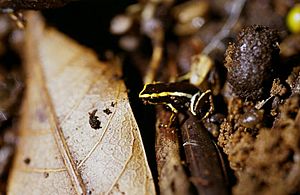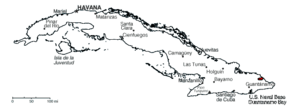Monte Iberia dwarf frog facts for kids
Quick facts for kids Monte Iberia eleuth |
|
|---|---|
 |
|
 |
|
| Individual on the forest floor (above), another on a hand showings the species' minute size (below) | |
| Conservation status | |
| Scientific classification | |
 |
|
| Distribution in Cuba in red |
The Monte Iberia eleuth (Eleutherodactylus iberia) is also called the Monte Iberia dwarf frog. This tiny frog is part of the Eleutherodactylidae family. It lives only in a small area of rainforest in eastern Cuba.
This special frog is critically endangered, meaning it is at high risk of disappearing forever. It is the smallest frog in the Northern Hemisphere. It is also the third smallest frog in the entire world. This tiny creature is only about 10 millimeters (0.4 inches) long. That's about the size of your fingernail! Only a few other frogs from the Southern Hemisphere are smaller.
Scientists first found this frog in 1993. It was discovered on Mount Iberia in Holguín Province, Cuba. This is how it got its name. There is still much to learn about this amazing little frog. It belongs to a group of Cuban frogs. Most of these frogs are also very small and have bright colors. Some, like the Monte Iberia eleuth, even have toxins in their skin.
Contents
Discovery of the Tiny Frog
This very small frog was first found by Cuban scientist Alberto R. Estrada. He worked with S. Blair Hedges from Pennsylvania State University. They were part of a program to study living things.
In 1993, they went on an expedition to Cuchillas de Moa. They were looking for the Cuban ivory-billed woodpecker, which is now thought to be extinct. During their search, they found four Monte Iberia eleuth frogs. They found them hidden under leaf litter and among the roots of ferns. This was in a forest on the side of Monte Iberia.
The discovery was later written about in a science journal called Copeia. This is where the name Eleutherodactylus iberia was first used.
What Does the Monte Iberia Eleuth Look Like?
Adult male Monte Iberia eleuths are usually about 9.6 to 10 millimeters (0.38 to 0.39 inches) long. The only adult female found so far was slightly larger, at 10.5 millimeters (0.41 inches).
This frog looks similar to two other tiny frogs, E. limbatus and E. orientalis. However, the Monte Iberia eleuth is usually darker. The lines on its back do not go as far down its body.
Because it is so incredibly small, this frog has fewer teeth than similar species. Its voice box is also tiny, about the size of a pinhead. This gives it a very high-pitched call. It makes a series of irregular chirps, like other frogs in its group.
Reproduction and Life Cycle
Scientists know very little about how this frog reproduces. One female frog was found next to a single egg. This suggests that the Monte Iberia eleuth lays only one egg at a time. It also hints that the parents might stay close to their young. This is common for animals that have only a few offspring at once.
Where the Monte Iberia Eleuth Lives
The Monte Iberia eleuth lives in only two separate places. Both are in the Holguín Province in eastern Cuba. They live in areas that are less than 600 meters (about 2,000 feet) above sea level.
The first place is on top of the Monte Iberia tableland, where the frog was first found. The second area is smaller, less than 100 square kilometers (38 square miles). This second area is near Nibujón, close to sea level. Over the last 40 years, human activities have caused many changes in this smaller area.
The Monte Iberia eleuth needs rainforests with wet soil to survive. It also needs very high humidity.
What the Monte Iberia Eleuth Eats
Even though it is tiny, the Monte Iberia eleuth eats like other small frogs. It hunts and eats many different small creatures without backbones. Its diet includes insects, moths, and spiders.
Images for kids
See also
 In Spanish: Ranita de Monte Iberia para niños
In Spanish: Ranita de Monte Iberia para niños


